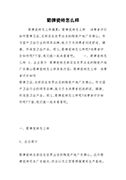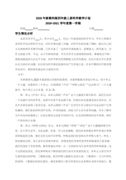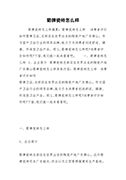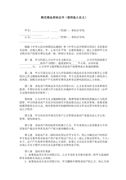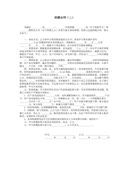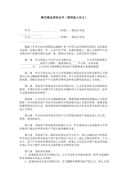牛津小学英语5A第三单元教案(精选2篇)五年级英语教案
牛津小学英语5A第三单元教案(精选2篇)
牛津小学英语5A第三单元教案 篇1
《牛津小学英语5a》第三单元
第一教时
教学目标:1.能听懂,会说,会读和会拼写单词:lesson, sing, song, dance, play.
2. 能听懂,会说,会读和会写句型: can you…?yes, i(we) can. / no, i (we) can’t.
3. 能听懂,会说,会读日常交际用语:ok. let’s start.
教具准备:1.磁带和录音机2.单词图片3.课文挂图a部分挂图1.4.歌曲“in the classroom”, “hot cross buns”.
教学过程:
1. free talk and revision
1) greetings.
2) try to say something about your own house. (draw a picture before class.)
2.presentation
1)
t: boys and girls, can you sing some english songs?
s: yes.
t: you can say “ yes, we can.”
s: yes, we can.
t: can you sing the song “we can sing and dance”?
s: no, we can not.
出示单词: sing song
s: 跟读。
t: what can you sing?
s: “abc song” , “ in the classroom”…
t: i can sing “ten little indians”, what can you sing?
s: i can sing “ how are you?”
t: good. let’s sing “ how are you?” first.
s: all right. / ok.
2)
t: boys and girls, can you sing?
s: yes, we can.
t: can you dance? (教师以动作示意)
s: yes, we can.
t: can you swim?
s: yes, we can.
t: (问单个学生) can you swim?
s: yes, i can. / no, i can’t.
出示句型: can you…?
yes, i can. / no, i can’t.
3)
t: can you ski?
s: yes, i can. / no, i can’t.
t: can you skate?
s: yes, i can. / no, i can’t.
t: i can play the violin. what can you do?
s: i can play the piano. / i can play the guitar.
出示单词:ski, swim, skate, play the violin, play the guitar
出示句型: what can you do?
i can …
3.practice
1) show the picture of part c. the students look at the picture of part c and ask an d answer in pairs:
i can … what can you do?
i can …
2) show the picture of part a and answer the questions:
who can you see in the picture?
what are they doing? (they are having a music lesson)
出示: a music lesson
4. consolidation
1) listen to the tape of part a and try to understand it.
read the text of part a on page 22 after the tape.( considering part a is too long for the students.we can divide into two parts and use two classes to teach them)
2) try to act the text.
5. homework
1) copy the words: lesson, sing, song, dance, play
do some written work (part c )
第二教时
教学目标:1.能听懂,会说,会读和会拼写单词:learn, listen, make, ride, put, can.2. 比较熟练的掌握句型: can you…?
yes, i(we) can. / no, i (we) can’t. 3. 能听懂,会说,会读日常交际用语:listen to … , please. now , follow me, please. yes. / ok. / all right. ok. let’s sing it together.
教具准备:1.磁带和录音机2.模型飞机3.课文挂图a部分挂图2.4.歌曲“we can sing and dance”.
教学过程:
1. free talk and revision
1) greetings
2) act part a on page 22.
2.presentation and practice
1)
t: can you sing the song “we can sing and dance”?
s: no, we can’t.
t: shall we learn the song “we can sing and dance” now?
s: yes.
t: listen to the song, please.
s: ok.
t: ( play the song.)
s: enjoy the song.
t: can you sing it now?
s: yes, we can.
t: good. let’s sing it together.
出示单词: listen
2)
t: (出示模型飞机的组件)
i can make a model plane, what can you do?
出示单词 make
s: i can make a model car.
出示词组 make a model plane, make a puppet
s: 跟读
反复练习句型: what can you do?
i can…
3.practice
1) chant:
a: what can you do? what can you do?
b: i can swim, i can run.
b: what can you do? what can you do?
c: i can sing, i can dance.
......
(开火车问答练习)
2)show the picture of part a. the students look at the picture and answer the questions:
who can you see in the picture?
what are they doing?
who can play the violin?
3) listen to the tape of part a
4)read the text.
4. consolidation
1)分角色朗读课文。2)表演对话。
5. homework
1)copy the phrase: make a puppet, make a model plane, play the guitar, play the violin
2)read the text.
第三教时
教学目标:1. 能听懂、会说、会读、会拼写单词:ride, put.
2. 进一步掌握句型 what can you do? i can … can you…? yes, i/ we can. no, i/ we can’t.3. 能正确掌握情态动词can的正确用法。4. 熟读对话,并初步改编或扩充本单元所学的对话。
教具准备:1.磁带和录音机2.单词图片3.课文挂图e4.歌曲“we can sing and dance”
教学过程:
1.sing “we can sing and dance”
2.free talk and revision
1) greetings.
2) look at the word pictures and say the words quickly.
3) read the text together.
3.presentation and practice
1) review the words:
t: i can swim. what can you do?
s: i can…
t: i can sing. what can you do?
s: i can…
(可出示单词图片让学生练习)
2) practice:
t: i can play the violin. can you play the violin?
s: yes, i can. / no, i can’t.
(the same method to practice the sentences)
t: i can ride a bike. can you ride a bike? (身体语言表示)
s: yes, i/ we can. no, i / we can’t.
t: i can put a book on my head. can you put a book on you head?
s: yes, i can.
板书: 词组: ride a bike, 单词: put
句型:i can …
can you …?
yes, i can. / no, i can’t.
practise those sentences using the verbs we’ve learned before.)
4. learn d & e
1) the students look at the picture of part d and fill in the blanks.
2) look at the pictures of part c and try to make some sentences.
3) read part e by yourselves and try to understand.
4) explain the dialogue and try to act it.
5.have a dictation of the words
6.homework
copy the words: listen, learn, ride, put
第四教时
教学目标:1.复习本单元所学词汇。2.能听懂会说、会读、会写句型: can you…?
yes, i(we) can. / no, i (we) can’t. what can you do? i can…能较熟练地在情景中运用所学句型和日常交际用语listen to … , please. now, follow me, please. yes. / ok. / all right. ok. let’s sing it together.。4.解元音字母a在单词里的读音。5.能有表情地演唱 ‘ we can sing and dance’
教具准备:1.part a 挂图2.单词图片3.歌曲“we can sing and dance ”
教学过程:
1.sing “we can sing and dance”
2.free talk and revision
1) greetings
2) act part a
3. learn part a ( the first paragraph)
1) t: listen to the tape please, and try to answer my questuion:
a.what time is it now?
b.where are the students?
c.what are they doing?
s: 听本课课文第一段介绍性录音磁带。
t: let’s say it by ourselves.
s: 复述本段。
3)t: can you act part a now?
s: yes, we can.
邀请同学上讲台表演,可分旁白、老师、高山等角色
4.learn f&g
1)t: boys and girls, let’s play a game ‘ hide and seek’.
(介绍游戏规则:捉迷藏)
where’s li hong? who can find him?
s: i can. he’s behind the door, i think.
t: oh, no.
s: he’s beside the window, i think.
t:oh, no.
s: …(继续猜测)
t: yes, you’re right.
(此游戏也可以扩展为找东西,一学生藏,其他学生找)
2)t: show the words on the blackboard:
after, basketball, class, dance
引导学生总结元音字母a在这些单词里的发音。并请学生举其他同类例子。
5.consolidation and do exercises
1)ask and answer using the drills:
can you…?
yes, i (we) can. / no, i (we) can’t.
what can you do?
i can…
2) finish the exercises on the workbook.
6. homework
1) review the words and expressions, prepare for the dictation
2) written work: part c. make sentences and transla
教后记:
牛津小学英语5A第三单元教案 篇2
unit 3 at a music lesson
第一教时
教学目标:
1.能听懂,会说,会读和会拼写单词:lesson, sing, song, dance, play.
2. 能听懂,会说,会读和会写句型: can you…?
yes, i(we) can. / no, i (we) can’t.
3. 能听懂,会说,会读日常交际用语:ok. let’s start.
教具准备:
1.磁带和录音机
2.单词图片
3.课文挂图a部分挂图1.
4.歌曲“in the classroom”, “hot cross buns”.
教学过程:
1. free talk and revision
1) greetings.
2) try to say something about your own house. (draw a picture before class.)
2.presentation
1)
t: boys and girls, can you sing some english songs?
s: yes.
t: you can say “ yes, we can.”
s: yes, we can.
t: can you sing the song “we can sing and dance”?
s: no, we can not.
出示单词: sing song
s: 跟读。
t: what can you sing?
s: “abc song” , “ in the classroom”…
t: i can sing “ten little indians”, what can you sing?
s: i can sing “ how are you?”
t: good. let’s sing “ how are you?” first.
s: all right. / ok.
2)
t: boys and girls, can you sing?
s: yes, we can.
t: can you dance? (教师以动作示意)
s: yes, we can.
t: can you swim?
s: yes, we can.
t: (问单个学生) can you swim?
s: yes, i can. / no, i can’t.
出示句型: can you…?
yes, i can. / no, i can’t.
3)
t: can you ski?
s: yes, i can. / no, i can’t.
t: can you skate?
s: yes, i can. / no, i can’t.
t: i can play the violin. what can you do?
s: i can play the piano. / i can play the guitar.
出示单词:ski, swim, skate, play the violin, play the guitar
出示句型: what can you do?
i can …
3.practice
1) show the picture of part c. the students look at the picture of part c and ask an d answer in pairs:
i can … what can you do?
i can …
2) show the picture of part a and answer the questions:
who can you see in the picture?
what are they doing? (they are having a music lesson)
出示: a music lesson
4. consolidation
1) listen to the tape of part a and try to understand it.
read the text of part a on page 22 after the tape.( considering part a is too long for the students.we can divide into two parts and use two classes to teach them)
2) try to act the text.
5. homework
1) copy the words: lesson, sing, song, dance, play
do some written work (part c )
第二教时
教学目标:
1.能听懂,会说,会读和会拼写单词:learn, listen, make, ride, put, can.
2. 比较熟练的掌握句型: can you…?
yes, i(we) can. / no, i (we) can’t.
3. 能听懂,会说,会读日常交际用语:listen to … , please. now , follow me, please. yes. / ok. / all right. ok. let’s sing it together.
教具准备:
1.磁带和录音机
2.模型飞机
3.课文挂图a部分挂图2.
4.歌曲“we can sing and dance”.
教学过程:
1. free talk and revision
1) greetings
2) act part a on page 22.
2.presentation and practice
1)
t: can you sing the song “we can sing and dance”?
s: no, we can’t.
t: shall we learn the song “we can sing and dance” now?
s: yes.
t: listen to the song, please.
s: ok.
t: ( play the song.)
s: enjoy the song.
t: can you sing it now?
s: yes, we can.
t: good. let’s sing it together.
出示单词: listen
2)
t: (出示模型飞机的组件)
i can make a model plane, what can you do?
出示单词 make
s: i can make a model car.
出示词组 make a model plane, make a puppet
s: 跟读
反复练习句型: what can you do?
i can…
3.practice
1) chant:
a: what can you do? what can you do?
b: i can swim, i can run.
b: what can you do? what can you do?
c: i can sing, i can dance.
…
(开火车问答练习)
2)show the picture of part a. the students look at the picture and answer the questions:
who can you see in the picture?
what are they doing?
who can play the violin?
3) listen to the tape of part a
4)read the text.
[nextpage]
4. consolidation
1)分角色朗读课文。
2)表演对话。
5. homework
1)copy the phrase: make a puppet, make a model plane, play the guitar, play the violin
2)read the text.
第三教时
教学目标:
1. 能听懂、会说、会读、会拼写单词:ride, put.
2. 进一步掌握句型 what can you do?
i can …
can you…?
yes, i/ we can. no, i/ we can’t.
3. 能正确掌握情态动词can的正确用法。
4. 熟读对话,并初步改编或扩充本单元所学的对话。
教具准备:
1.磁带和录音机
2.单词图片
3.课文挂图e
4.歌曲“we can sing and dance”
教学过程:
1.sing “we can sing and dance”
2.free talk and revision
1) greetings.
2) look at the word pictures and say the words quickly.
3) read the text together.
3.presentation and practice
1) review the words:
t: i can swim. what can you do?
s: i can…
t: i can sing. what can you do?
s: i can…
(可出示单词图片让学生练习)
2) practice:
t: i can play the violin. can you play the violin?
s: yes, i can. / no, i can’t.
(the same method to practice the sentences)
t: i can ride a bike. can you ride a bike? (身体语言表示)
s: yes, i/ we can. no, i / we can’t.
t: i can put a book on my head. can you put a book on you head?
s: yes, i can.
板书: 词组: ride a bike, 单词: put
句型:i can …
can you …?
yes, i can. / no, i can’t.
( practise those sentences using the verbs we’ve learned before.)
4. learn d & e
1) the students look at the picture of part d and fill in the blanks.
2) look at the pictures of part c and try to make some sentences.
3) read part e by yourselves and try to understand.
4) explain the dialogue and try to act it.
5.have a dictation of the words
6.homework
copy the words: listen, learn, ride, put
第四教时
教学目标:
1.复习本单元所学词汇。
2.能听懂会说、会读、会写句型: can you…?
yes, i(we) can. / no, i (we) can’t.
what can you do?
i can…
能较熟练地在情景中运用所学句型和日常交际用语listen to … , please. now, follow me, please. yes. / ok. / all right. ok. let’s sing it together.。
4.解元音字母a在单词里的读音。
5.能有表情地演唱 ‘ we can sing and dance’
教具准备:
1.part a 挂图
2.单词图片
3.歌曲“we can sing and dance ”
教学过程:
1.sing “we can sing and dance”
2.free talk and revision
1) greetings
2) act part a
3. learn part a ( the first paragraph)
1) t: listen to the tape please, and try to answer my questuion:
a.what time is it now?
b.where are the students?
c.what are they doing?
s: 听本课课文第一段介绍性录音磁带。
t: let’s say it by ourselves.
s: 复述本段。
3)t: can you act part a now?
s: yes, we can.
邀请同学上讲台表演,可分旁白、老师、高山等角色
4.learn f&g
1)t: boys and girls, let’s play a game ‘ hide and seek’.
(介绍游戏规则:捉迷藏)
where’s li hong? who can find him?
s: i can. he’s behind the door, i think.
t: oh, no.
s: he’s beside the window, i think.
t:oh, no.
s: …(继续猜测)
t: yes, you’re right.
(此游戏也可以扩展为找东西,一学生藏,其他学生找)
2)t: show the words on the blackboard:
after, basketball, class, dance
引导学生总结元音字母a在这些单词里的发音。并请学生举其他同类例子。
5.consolidation and do exercises
1)ask and answer using the drills:
can you…?
yes, i (we) can. / no, i (we) can’t.
what can you do?
i can…
2) finish the exercises on the workbook.
6. homework
1) review the words and expressions, prepare for the dictation
2) written work: part c. make sentences and translate.


